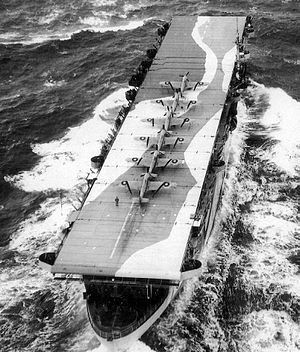Avenger-class escort carrier
 HMS Avenger | |
| Class overview | |
|---|---|
| Name | Avenger class |
| Builders | Sun Shipbuilding Company |
| Operators | |
| Preceded by | Long Island class |
| Succeeded by | Attacker class (RN), Bogue class (USN) |
| Built | 1941–1942 |
| Planned | 4 |
| Completed | 4 |
| Lost | 2 |
| General characteristics | |
| Type | Escort carrier |
| Displacement | 8,200 long tons (8,332 t) |
| Length | 492.25 ft (150.04 m) |
| Beam | 66.25 ft 6 in (20.35 m) |
| Draught | 23.25 ft (7.09 m) |
| Installed power | 8,500 shp (6,300 kW) |
| Propulsion |
|
| Speed | 16.5 kn (19.0 mph; 30.6 km/h) |
| Complement | 555 |
| Sensors and processing systems | SC radar |
| Armament |
|
| Aircraft carried | 15 |
| Aviation facilities |
|
| Notes | Class only had a half hangar for aircraft stowage |
The Avenger-class escort carrier was a class of escort carriers comprising three ships in service with the Royal Navy during the Second World War and one ship of the class in the United States Navy called the Charger Type of 1942-class escort carrier.[1][page needed] All three were originally American type C3 merchant ships in the process of being built at the Sun Shipbuilding and Drydock Company Chester, Pennsylvania. The ships laid down in 1939 and 1940 were launched and delivered to the Royal Navy by 1942 under the Lend-Lease agreement.[2][3]
The ships had a complement of 555 men and an overall length of 492.25 feet (150.04 m), a beam of 66.25 feet (20.19 m) and a height of 23.25 ft (7.09 m).[2] Their displacement was 8,200 long tons (8,332 t) at normal load and 9,000 long tons (9,144 t) at deep load. Propulsion was provided by four diesel engines connected to one shaft giving 8,500 brake horsepower (6,300 kW), which could propel the ships at 16.5 knots (30.6 km/h; 19.0 mph).[4]
Aircraft facilities were a small combined bridge–flight control on the starboard side and above the 410 feet (120 m) long wooden flight deck, one aircraft lift 43 by 34 feet (13 m × 10 m), one aircraft catapult and nine arrestor wires. Aircraft could be housed in the 190 by 47 feet (58 m × 14 m) half hangar below the flight deck.[4][5] Armament comprised three single mounted 4-inch dual purpose anti-aircraft guns and fifteen 20 mm cannons on single or twin mounts.[4] They had the capacity for fifteen aircraft which would typically be a mixture of Grumman Martlet or Hawker Sea Hurricane fighter aircraft and Fairey Swordfish or Grumman Avenger anti-submarine aircraft.[4] The three ships in the class were HMS Avenger, HMS Biter and HMS Dasher. A fourth ship, USS Charger was built at the same time to the same design but was commissioned in the U.S. Navy.[4]
Service history[edit]
HMS Avenger[edit]
HMS Biter[edit]
HMS Dasher[edit]
USS Charger (CVE-30)[edit]
See also[edit]
Notes[edit]
- ^ Silverstone, Paul H (1965). US Warships of World War II. Annapolis, Maryland: Naval Institute Press. ISBN 0-87021-773-9.
- ^ a b Cocker (2008), p.78.
- ^ "Sun Shipbuilding, Chester PA". Ship Building History. Archived from the original on 10 February 2012. Retrieved 1 October 2010.
- ^ a b c d e Cocker (2008), p.79.
- ^ Poolman (1972), p.29.
References[edit]
- Cocker, Maurice (2008). Aircraft-Carrying Ships of the Royal Navy. Stroud, Gloucestershire: The History Press. ISBN 978-0-7524-4633-2.
- Gardiner, Robert; Chesneau, Roger (1980). Conway's All the World's Fighting Ships 1922-1946. Mayflower Books. ISBN 0-8317-0303-2.
- Silverstone, Paul H (1965). US Warships of World War II. Annapolis, Maryland: Naval Institute Press. ISBN 0-87021-773-9.
- Poolman, Kenneth (1972). Escort Carrier 1941–1945. London: Ian Allan. ISBN 0-7110-0273-8.


 French
French Deutsch
Deutsch